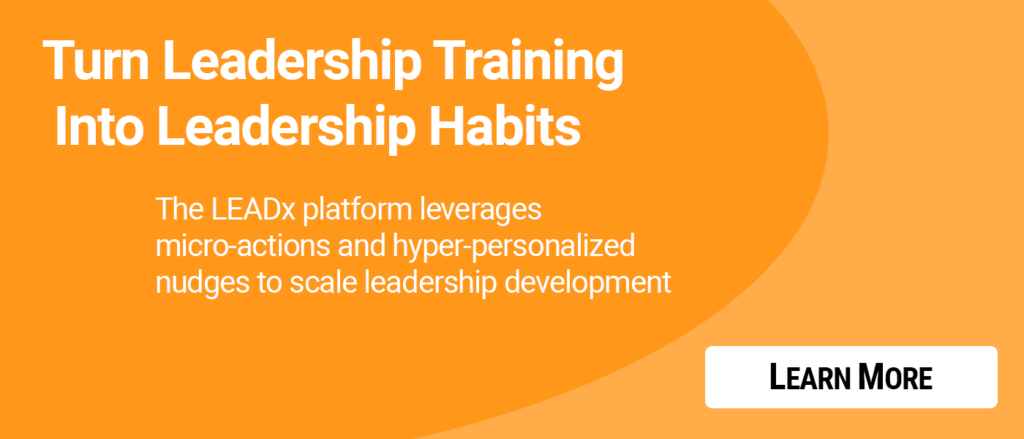
How does a 147 year old institution quickly scale and sustain a culture of leadership and engagement?
The Los Angeles Public Library (LAPL), serving 18 million residents, is the second-largest library system in the U.S. As recently as 2018, there was no shared definition of leadership among LAPL’s 1,100 employees, and only half of employees believed that there were opportunities to grow as a leader. Now, only a year later, that number has skyrocketed to nearly 90 percent.
To learn how LAPL made such dramatic progress, I spoke to Julie Lamba, an educator turned leadership development consultant who has spent her entire career testing learning techniques in various organizational settings.
Lamba is an executive fellow at FUSE Corps, a national non-profit organization that places mid-career professionals in city and county government agencies to design and implement strategic projects. These projects take on a range of issues facing urban communities around the country, including economic and workforce development, healthcare, public safety, climate change and education.
Lamba is currently in the final stages of building a leadership development program for LAPL. Having been in the private sector for most of her career, Lamba joined FUSE Corps to learn more about the public sector and do mission-driven work. And, being new to Los Angeles, she saw the importance of getting to know the city and the local issues facing it as she put down roots.
Much of Lamba’s success in helping LAPL develop its next generation of leaders is the result of a learning philosophy she cultivated early in her career as a 5th-grade math teacher.
“I had an instructional coach who would come into my classroom to observe me teaching three days a week, and afterward, he would leave a slip of paper on my desk with two or three very specific and actionable pieces of feedback,” said Lamba. “This approach catalyzed such rapid growth for me that, the very next year, I saw a 10 percent improvement in the number of my students who achieved proficiency on their standardized tests.”
Shifting from leadership training to leadership habits
According to Lamba, many of the leadership development methods companies use haven’t caught up to the science of learning and behavior change.
“If you really want people to engage with what you're offering, you have to figure out to make the experience engaging, valuable, and doable, in a way where people can observe their own growth over a period of time” said Lamba.
This rarely happens after a typical multi-day leadership conference. Even though most leadership events have gone virtual, most of us know what it’s like to attend a big professional development event. You hear three days worth of great content, only to be thrust back into your job (and all new work that’s come up while you were gone) while you struggle to plug what you’ve learned into your day-to-day. Studies have shown that, within just 24 hours of attending a training session, attendees will forget 70 percent of the information presented. And you can’t apply what you don’t remember.
Scaling leadership behaviors with nudges and micro-learning
In his bestselling book, Atomic Habits, James Clear writes at length about how micro-actions can produce macro results.
“Too often, we try to convince ourselves that massive success requires massive action,” Clear writes. “Meanwhile, improving by one percent isn’t particularly notable—sometimes it isn’t even noticeable—but it can be far more meaningful, especially in the long run.”
So rather than sending a handful of people to a single conference or off-site leadership training, Lamba implemented a much more accessible, organization-wide program, including equipping 120 LAPL managers and executives with 15 to 30 minutes of actionable micro-learning per week. The approach of using small, personalized doses of content to inspire change over time is the key to habit-driven learning.
But how do you get people to engage with content regularly enough to form habits around leadership development? According to Clear’s Laws of Behavior Change, there are several steps.
- Make it obvious.
For LAPL, Lamba deployed a leadership coaching application accessible via smartphone, tablet or desktop. The library’s employees would see the app on their home screens frequently, or get behavioral “nudges” reminding them to engage with the content (e.g., micro-learning videos, book summaries, webinars, podcasts, job aids). Implementation of the app was also connected to a broader, highly visible, effort to establish and practice organization-wide leadership values. Whatever content medium you choose, make sure it’s conspicuous, and consider creating nudges for employees to engage.
- Make it attractive.
Instead of a one-size-fits-all approach, LAPL gave its managers the ability to choose the training modules that sparked their interest. People are much more motivated to learn when the topic at hand is something they want to learn about, so consider giving employees some optionality to make the program more custom and personalized.
- Make it easy.
With LAPL’s leadership coaching application being one tap away, library employees could access it at any time, from anywhere, with reminders and content being delivered directly to their inboxes. Make sure the program you choose has a simple sign-up process and is easy to use. The more hoops employees have to jump through and the longer it takes to get to the “meat,” the less likely they’ll be to engage on a regular basis.
- Make it satisfying.
There are few things more satisfying than observing your own growth, and LAPL’s employees got to experience this firsthand. Lamba noted an instance where, before going into a feedback conversation with a direct report, a manager searched for an actionable piece of content with tips on giving constructive feedback. Then she actually applied what she learned in the meeting and walked away feeling pleased about how the conversation went.
“Before I reviewed the feedback module, I was worried about how my employee would react. This made me hesitant to bring it up,” said Jane Dobija, an LAPL branch manager. “The framework helped me set a clear goal for the conversation, and made me feel more confident about my approach. Ultimately, my employee was able to process the feedback and make the adjustments needed.”
While Clear’s Laws of Behavior Change technically end there, I’d venture to add a fifth step when it comes to habit-driven learning: Make it about community.
“There's a sense of camaraderie that comes with this method of learning, especially when aiming to fulfill the library’s mission for the public.” said Lamba. “It feels like something we're all doing together, as opposed to something that a few people are doing or that individuals are doing alone. I don’t think the community aspect would be as strong with other leadership development formats.”
A few of LAPL’s managers have even decided to start a monthly discussion group with others in their department so they could exchange their experiences and learnings with each other, which generates more positive reinforcement of what they are practicing.
Encourage employees to have conversations about what they’re learning and ask questions. It’s inspiring to watch a group of people learning and growing together. You’ll be amazed at how a community of people committed to long-term learning will energize your culture.







